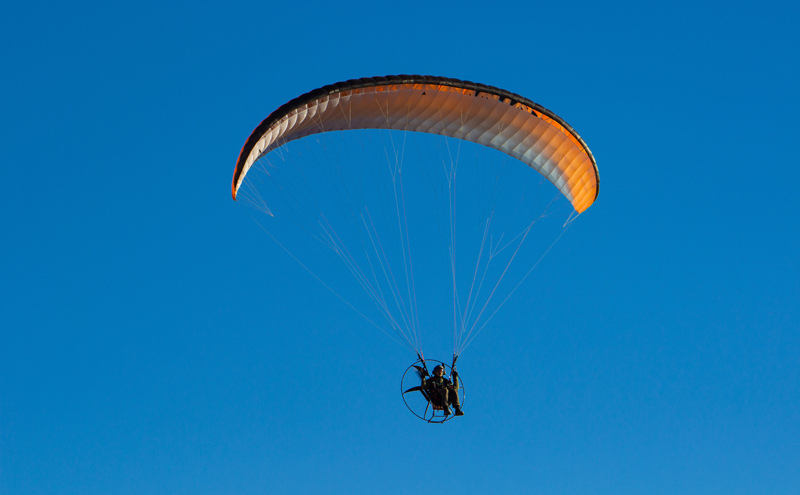There are many things a person can do to get an adrenaline rush. We usually get that rush when we do something that is so thrilling and exciting. Something we aren’t used to doing on a normal daily basis.
Imagine flying on top of the mountains? How about flying over a large body of water? You’d feel the thrill of being able to fly like a bird. That is a dream almost every person’s had at one point or another!
Flying a paramotor becomes so easy once you’ve mastered the skill. We will be discussing paramotor speed, what affects it, and how fast you can go.
Average Paramotor Speed
The average paramotor speed is 30 mph, that is if there is a small amount of wind. If you’re flying in a more open area and there’s strong tailwind you’d probably go 70 mph or even more!
If it’s just not your day and you have to go against the wind. You’ll probably travel 3-5 mph, which won’t get anywhere if you’re in a rush, like a competition!
Wind and Speed
The wind is your strongest tool to use when flying a paramotor. Using the wind can help you to reach your destination faster or it can slow you down to the point of not moving.
Having a slight breeze can actually slow down your paramotor or even cause it to stop altogether.
Sometimes, having zero ground speed won’t completely stop your paramotor. Meaning that your paramotor will still be airborne since the air is still rushing through the wings. That creates the lift that is needed to continue.
When there is a gradual rise in the wind gradient this might cause the pilot to stop. Some pilots though prefer to keep going but flying in a backward motion.
Before flying, we recommend that you check the wind speed and direction. Plan your route accordingly for better results.
Planning The Route
There are a couple of things you might want to keep in mind before flying.
- Check if there are any airports nearby.
- Check how long your distance is and plan your fuel accordingly.
- Figure out what is your average speed.
- Emergency landing options.
- Check the weather and wind speed during the time of your flying.
Paramotor Wings and Speed
There are so many types of wings out there. Each is designed on whether you are still a beginner or a professional pilot.
The faster wings are for the more advanced pilots. Those wings have more techniques that the professionals could use to be able to fly more efficiently and safely.
The beginner wings are more stable but they are also slower. They are less likely to be damaged during the slow landing.
Each wing comes with a speed bar. The speed bar gives your paramotor a few extra mph speed. How that works is that when you are in a full reflex mode you can activate the speed bar with your feet.
What that does, it pulls on 3 different lines along with the leading edge of the wing. That makes your paramotor gain more airspeed and makes the wing more stable. Giving you a few extra mph speed during the flight.
Weight and Speed
You’d think that the heavier the paramotor the slower it becomes. Oddly enough that isn’t true in this case. With paramotors the heavier the weight the faster it actually goes.
Although having more weight does, in fact, make you go faster. You’ll find that it has a harder drag and a slightly harder takeoff. If that doesn’t bother you and you just want more speed, then we suggest buying a wing that is on the heavier side.
You’ll find also that having a wheeled paramotor will go faster than the regular ones. With paramotors that are heavy though, you’ll need to exert more effort to stay up!
You should also know that heavier paramotors burn more fuel than the regular ones.
The same concept is applied to the pilot’s weight. The heavier the pilot the faster he will go even if he is using beginner wings. So it wouldn’t be such a bad idea to fly in a double user paramotor.
Speed Limitation
What limits the speed is the amount of drag that is produced by the wing. When you’re flying at full power, you’ll find that the wing is flying behind you. The paramotor is in front of the wing and that is due to the drag that the wing is producing.
When you’re in full reflex mode, you are reducing the lift and drag that’s how you get to fly faster. But the wing starts to produce the lift and drag which means you’ve reached the top speed. Thus making the speed limited.
Collapsing Wings
There is a term called “angle of attack”. That is the angle at which the wing cuts through the air. Turning at high-speed effects that.
When you turn at high speed, that causes you to yank on the strings, which is very dangerous when flying. That causes the wing to collapse.
On a bright note, collapsing wings is manageable but it should be avoided.
The Bottom line
The bottom line is that paramotor speed is controlled by the wind, wing, and the speed bar. The weight also plays a factor with the speed. The heavier the weight the better!
Plan your route accordingly to avoid any issues during the flight. We recommend checking the weather especially wind direction and set your route accordingly.
Plan plenty of stops if you’ll be flying for a long time. Make sure to know how much fuel your paramotor burns so you’d avoid running out of fuel in the middle of flying.
You should test out paramotoring first before buying your own paramotor. Often times we think we are into something but once we try it we find out that it might need more work than anticipated.
Like most things in life remember that practice makes perfect!

